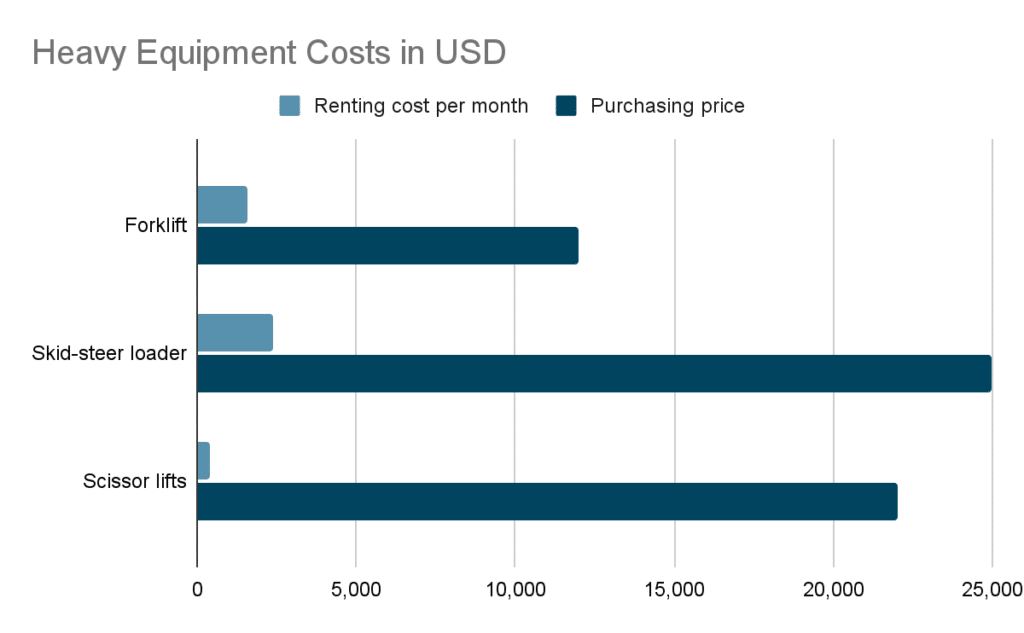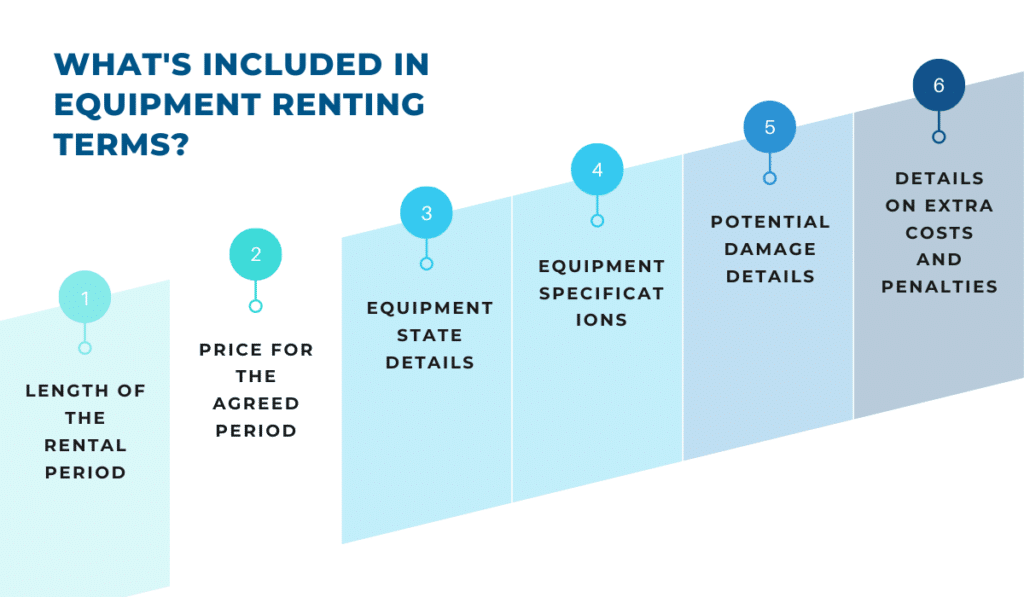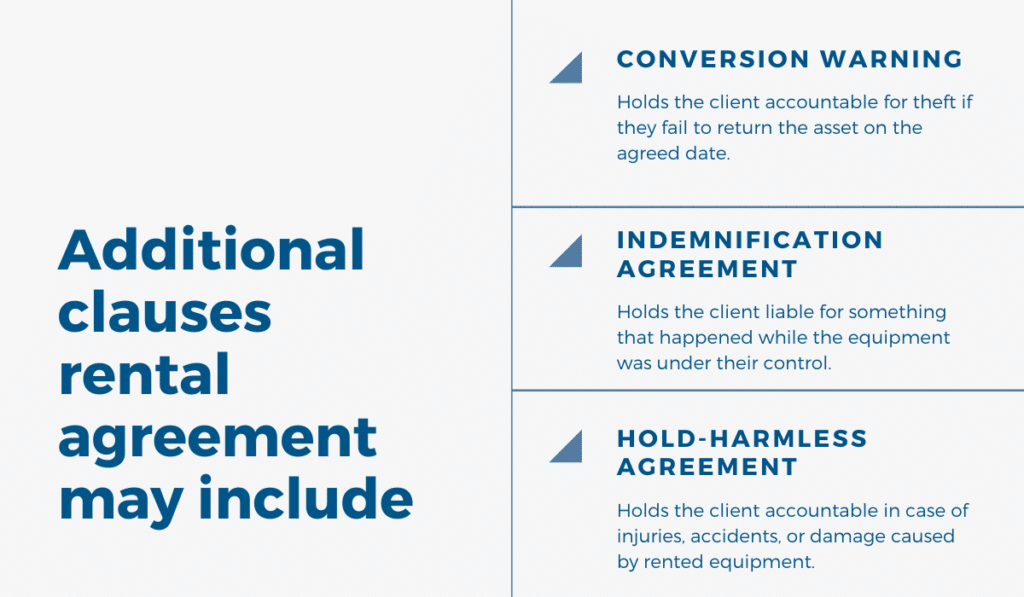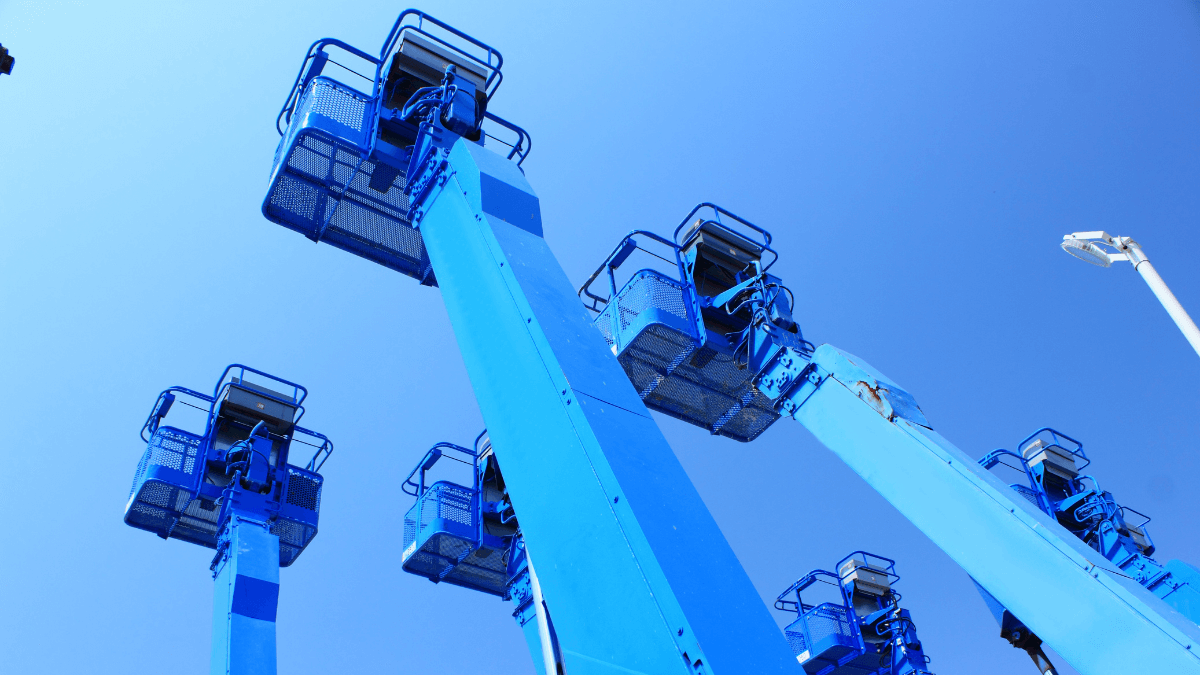It’s no secret that the heavy equipment rental market is on the rise. After all, it reached the value of $103bn in 2020 and should reach $137bn in the next five years.
Clearly, there’s a lot of money in this industry.
However, it’s not exactly an easy buck—equipment owners have to invest in maintenance, tracking, insurance, and customer care.
Do you want to know how to do this with ease?
This article will explain the seven factors you should consider in the renting business.
Don’t worry, you’ll also find actionable advice on how to do it!
In this article...
Take Good Care of Your Rental Fleet
When renting your equipment to others, you should always make sure that it’s in good condition.
It might seem obvious, but this is an often overlooked step—60% of companies still fix their assets only after they break down. This type of upkeep is also called reactive or run-to-failure maintenance. If you couldn’t tell by the name, it renders your equipment useless.
Such businesses believe they can use their failing machinery as long as the clients don’t have any complaints.
But what happens when the equipment suddenly malfunctions in the middle of a project?
In that case, you’ll find yourself in deep trouble.
On top of the risk of coming across as an unprofessional and unreliable vendor, you’ll also have to take specific steps to remedy the situation, including:
- finding a way to transport the machinery back to your maintenance team
- transporting a functioning replacement item to the client’s worksite
- procuring the machine if you don’t have an extra or an available one in your fleet
- covering the costs of transport, delays, and repairs
Sounds like too much hassle? That’s because it is.
Let’s face it—not taking care of your equipment wastes your time, energy, and resources on something that you could have prevented.
All you have to do to avoid this dreadful scenario is regularly maintain and inspect your heavy machinery.
The best way to go about it is to schedule regular maintenance. Nowadays, there’s no point in doing this manually for each piece of heavy machinery.

Instead, different software can do this for you as well as remind you of an upcoming upkeep session. This type of solution ensures that your equipment is in top condition before and after every use.
Such an approach allows your maintenance team to spot even the slightest potential problems and fix them before they result in a breakdown.
Since you’re in the rental business, your equipment should look presentable as well. Therefore, regular maintenance is beneficial to you in that sense too. It gives your team the chance to visually inspect and correct any damage to the exterior, including rust and chipped or uneven color.
Overall, paying attention to the state of your rental fleet helps you stay on track and save time and money.
Try to Make the Most Out of Your Equipment
Staying on top of what equipment you have, and where it is, helps you get the most out of it.
Before we dive into how you can use your assets to their full potential, we will take a look at the cost of purchasing versus renting heavy equipment monthly.
The analysis will stress why it financially pays off to make the most out of your rental equipment.

Let’s analyze this graph.
As a rental company, you’ll pay $12,000 for a brand new forklift. The monthly average renting rate is $1,600, so you’ll pay it off in seven and a half weeks.
Anything after that is pure profit, but we also can’t forget about all the expenses that come from owning equipment.
We get to ten and a half weeks of renting before reaching profit if we do the same calculation for a skid-steer loader ($25,000 new, $2,400 rent fee). The analysis of scissor lifts costs ($22,000 new, $400 monthly renting rate) brings you to a surprising 55 weeks!
The point is, when you rent equipment to others, it takes a while for your initial investment to pay off. After that, the earnings are net revenue. Because of this, you need to ensure that you cover the expenses and turn a profit.
How can you do that for each piece of equipment?
Easy—just track it.
You’ll know precisely where your asset is, its condition and maintenance status, and whether it’s available for a new project.
What does this mean?
Let’s say your forklift gets misplaced after a couple of months of owning it. Up to that point, it was rented for three weeks total, which means you’ve earned less than half of what it cost you.
Why waste over $6,000 when you can track the equipment to know who is using it, where it is, and when it can be used next? Tagging your machinery with QR codes allows for seamless checkouts and tracking of every tagged piece.
You’re probably wondering how you can start tracking your rental heavy construction equipment.
Here’s what to do.
- Create an inventory of all your assets, including all the necessary data, images, and manuals
- Add the data to a specialized equipment tracking software
- Assign a unique identifier code to each asset
- Label the asset with a durable tag that can withstand outdoor conditions
- Scan the tag whenever your machine goes out or comes back in or look up the code to access equipment details
Such a tracking solution is easy to set up and simple to use, which means you can start using it as soon as possible. If you want to get the most out of your equipment, start tracking it.
Protect Yourself from Additional Costs
As a rental business, take measures to protect yourself from additional costs which can quickly rack up.
Let’s face it: rental businesses are always at risk.
You’re not the one who uses the equipment. As such, you don’t have direct knowledge of what happens with it in the field. However, you can still be held liable for any accidents in spite of this.
What this means is that someone can use your assets for the wrong purpose, or misuse them in other ways, causing damage or an accident and saddling you with the bill.
Unfair? Yes.
But it is also very preventable.
Let’s see how you can protect your rental company from additional costs.
Your safest bet is to get proper insurance. There are many different insurance options, but we will list some of the most important ones for rental businesses.
The general liability policy will help you in case of damage to the equipment, people, or property using your asset, even when it is rented out. Smaller companies pay up to $600 for such policies, which is much less than you’d pay if found liable for the accident.
Something you may also find beneficial is business interruption insurance.
How does it work?
When your business stops because of damage or accidents, the insurance covers the lost income until your business is up and running again. Without this coverage, you’re losing out on profits until you get back to work.
On top of that, you should consider getting inland marine insurance. If you don’t know what it is, you should, as it helps cover additional aspects, such as shipped cargo and loss during transport.
Here’s what this type of coverage offers:

The thing is, there are many options you can choose from when it comes to insurance. Your best bet is to analyze your needs and make a decision based on them. Sometimes, it will mean getting more than three types of insurance.
But remember, while insurance does cost you, it’s even more expensive not to have a policy in place. Without it, one bigger accident could bankrupt your business.
Is that something you can afford?
Offer Equipment Training
Rental equipment companies don’t always offer equipment training, but when they do, it pays off.
Usually, businesses rent out the asset and hope the clients will take care of it properly. Instead, you should take it upon yourself to explain how your customers can do basic upkeep themselves to optimize the equipment.
If a company is interested in renting a tractor but doesn’t have an employee who knows how to handle it, they might ask you if you provide equipment training. Why not include it?
This option helps you ensure that the client uses your asset correctly without damaging it. Besides, you can charge extra for the training. Two birds, one stone!
For instance, one of the foremost American rental equipment provider companies, United Rentals, also offers highly sought-after equipment training courses on topics ranging from job site safety (including essential OSHA certifications) to plant and facility maintenance.
When thinking of what you can do for customers, teaching them how to perform essential maintenance is high on the list.
Here are some of the things you can teach customers about:
- checking and filling fluids, including oil, coolant, hydraulic fluid, and fuel
- greasing crucial equipment parts
- sharpening asset parts like blades or knives
- cleaning the machine and removing debris
The best part is that customers are more likely to recognize an issue if they maintain the asset, which means you’ll hear about it before a major malfunction occurs
Always Be Available for Help
How much does excellent customer service mean to you? In the equipment rental business, it’s a deal-breaker.
Don’t trust us?
Take a look at what the major industry players had to say in the 2021 rental industry report.
Key decision-makers in the industry, from accounts managers to CEOs, who were interviewed for the report claim that their company goals will center around customer retention and support this year.
This doesn’t come as a surprise after a rough year for the industry in general brought on by the pandemic. The rental business was on the rise for years until it faced a 1.7% decline in 2020.
In light of this, many companies decided to turn their focus to keeping customers and improving their experience. Why not do the same?
Clearly, loyalty means repeat customers and income, so investing in it benefits you.
So, how can you excel at customer support?
First, you have to allow customers to get in touch with you or your team easily. When they encounter an issue with the equipment, they will have to contact you quickly.
Here’s the thing—it’s your job to make that possible.
For starters, offer more than one contact channel option, such as:
- phone
- live-chat
- social media
- apps like Whatsapp and Viber
- in-app support (if applicable)
When deciding which options are the most suitable, consider that the pandemic has also changed the way clients contact customer support.

According to Zendesk, customer service specialists, channels like Whatsapp, text, live chat, and social media have experienced an incredibly high rise during the pandemic. More people are starting to contact CS using their phones and apps.
Do you offer those options? If not, look into it.
Once you select different communication channels, it’s time to put them to good use! See if there is anything more you can do for your customers, or if there’s any additional information you can provide.
Another aspect of customer service you can consider is publishing extensive instructions on your website.
If your clients decide to look for more info online, you should make it possible to find everything on your website, including FAQs based on other customer’s requests and feedback, a detailed knowledge base, and instructions on how to handle different scenarios.
The bottom line is: if you want to tap into the potential of great customer service, offer different contact channels, written instructions, and manuals. Helping clients makes them stay with your company.
Determine the Renting Terms
Your renting terms are the key to your business because they set the rules for you and the customers, offering protection for both parties involved.
Therefore, you must determine the terms ahead of time and stick to them. If you create renting agreements on the spot, you can easily miss a step or two, causing future business losses.
Rather than risking that much, establish set renting terms that you will offer to each customer.
Now that it’s clear why you need to agree on these terms beforehand, the question is: what to include?

Here’s a list of all the obligatory aspects necessary for good renting terms:
- length of the rental period: how long the client can legally keep the asset
- price: fixed or variable, depending on the rental period length and equipment quantity
- equipment state: the asset’s current condition and what you see as an acceptable state for return
- equipment specifications: what the customer is getting and what they can use the item for
- damage: what you consider to be damage to the equipment and how much you will charge for different types of damage
- extra costs: the price of additional days (after the agreed return date), possible penalties
After you have covered these basics, look into what you want your clients to sign.
Take, for instance, this company, which covers the terms of use, describes the user’s duties and the conditions of termination, as well as no-agency and no-license clauses.
Most rental companies also cover conversion warnings, indemnification, and hold-harmless agreements.
What do these additional clauses get you?
The conversion warning allows you to hold the client accountable for theft if they fail to return the asset on the agreed date.
It might seem excessive, but having this guarantee that you’ll have the equipment when required will prove invaluable for ensuring the operations in your company run smoothly, as most of the time, you’ll also be on a tight schedule and unable to afford delays.
Bear in mind that your business and reputation will suffer if you keep allowing delays.

Then, the indemnification agreement helps you hold the client liable if you get sued for something that happened while the equipment was under their control. This point ensures that you don’t waste a lot of money on fixing your clients’ errors.
Finally, the hold-harmless agreement ensures that you won’t be held accountable by the client in case of injuries, accidents, or damage caused by your equipment.
However, while these additional clauses may protect you, don’t make the entire contract about you. Instead, make an effort to explain what the client will get from you. This section can include anything from equipment transport to operator training.
So, what’s the magic formula of renting terms?
Decide what you want to include to transfer accountability to the customer, but make sure to mention the benefits you offer.
Don’t Forget About Equipment Transport
Clients don’t want to be in charge of transportation costs. After all, why should they pay the costs of getting the equipment from one of your warehouses to the construction site?
That’s exactly why you should include the transport costs into your rental price. Many clients would be willing to pay a bit extra if it meant getting rid of the responsibility of transferring machinery around the country.
However, transporting heavy equipment can cost anywhere from $1.75 up to $5.00 per mile, which isn’t exactly ideal for making a profit.
We know what you’re thinking: how can I make this financially easier on the company?
It’s simpler than you think!
If you’re a bigger company, consider establishing dispatch centers.
What does this include? You’ll have a couple of warehouses in multiple sites, which will allow you to transport the equipment quicker than if you only had one central location.
Since having warehouses all over the country might be too expensive, think about investing in specialized trailers or trailer beds. That way, you’ll have your transport vehicle and be able to quickly bring your machinery to the worksite as promised.
And here’s our tip for choosing the correct type of trailer.
Always consider the weight of your heaviest equipment. The standard trailer for transporting equipment, the flatbed trailer, usually carries up to 24 tons of weight, so consider whether the items you want to transport fit into these specifications.
If you want to use the trailer for more than one asset at a time, double the weight to ensure you always have a vehicle for the job.
Since such equipment can be too big of an investment for smaller businesses, you can always consider towing your assets to the client. All you need to do is rent a vehicle and deliver the machinery to the worksite while saving on some costs.
If you decide to cover the equipment transport costs, think of the most accessible and affordable way to do it.
Conclusion
The heavy equipment rental industry has been on the rise for a long number of years because companies find it simpler to rent such machinery than own it.
However, what to do when you are the one who rents it to others?
Timely maintenance and equipment tracking to prevent losses and theft help you foster a positive reputation as a reliable provider among your clients.
You can ensure that your relationship with your clients remains satisfactory even in unfavorable circumstances by establishing transparent terms of use and liability policies, while catering to their needs through thorough equipment training and outstanding customer support.
With such an approach to doing business, there’s nothing standing in the way of your success.
Voilà, you’re all set to rent!





